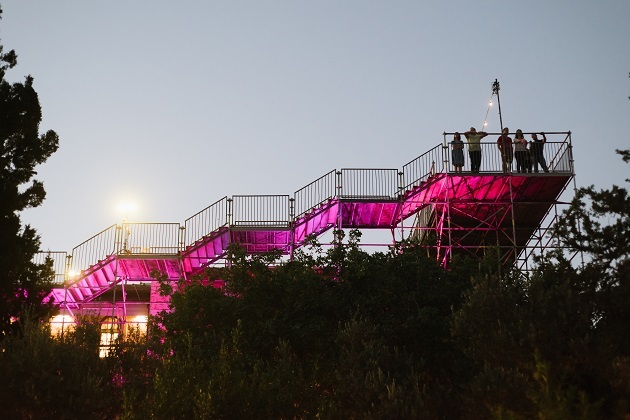 HQ Architects created 90 Degrees, a colourful scaffolding system wrapped around the venue. All images courtesy of Dor Kedmi
HQ Architects created 90 Degrees, a colourful scaffolding system wrapped around the venue. All images courtesy of Dor Kedmi
Jerusalem Design Week was an ambitious exploration of our politically constructed world map – if not of the conflict on its doorstep, finds Priya Khanchandani
For centuries, Jerusalem has been a contested city: a place of unending conflict and upheaval, torn between the hands of divided groups seeking to assert sovereignty over it. Each has left its mark, from the luminous Western Wall to the glistening Dome of the Rock. Through all of this one unifying characteristic – superficially at least – has been the sandy stone of Jerusalem’s skyline. A law from 1918, still in force today, mandates that all new buildings are clad in this stone.
This year’s eighth edition of Jerusalem Design Week, which brought together the work of over 200 designers and drew 6,000 visitors at its opening one balmy June evening, is another way in which design seems to be bringing people together, despite the political context of both the city and Israel at large.
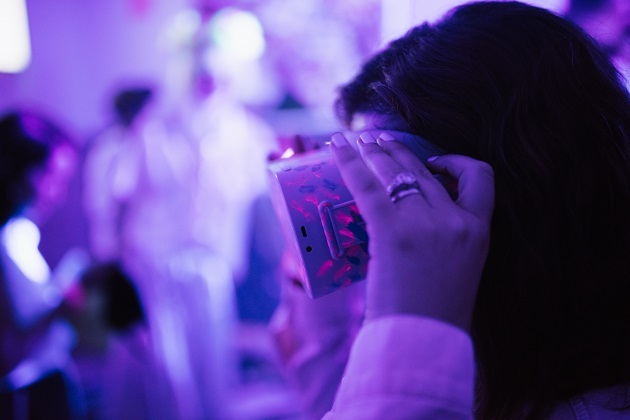
The event’s most memorable parts were the immersive installations, which enabled Jerusalem Design Week to stand out against much bigger design weeks in much bigger cities. Creating queues at the cordon was Club All: Maximalism and Hyperreality in Modern China, an exhibition space-cum-Chinese nightclub complete with a DJ and dance floor, curated by Hadas Zucker. Named after a subcultural club in Shanghai, Club All contained a combination of video art, conceptual design and live performance. In one room, sports trainers were reconstructed into pollution masks, which formed a stark commentary on consumerism and its role in diminishing the air quality in China. In the cloakroom, a fictional fashion brand was re-appropriated to highlight the excessive use of branding in Chinese popular culture. The most overwhelming part was an area covered in psychedelic images that lit up in ultraviolet light, with a set of AV headsets that took you further into a surrealist fantasy. It invoked a minimalism verging on entropy.
If you were over-stimulated by all of this, then respite was at hand in the nearby Siri Zen Master by locally based trio the Varburg Group, a calm, cave-like installation where the voice of Siri talked to you in the form of a spiritual master. ‘I cannot tell you any spiritual truth that you don’t already know,’ it uttered enigmatically. Meanwhile, visitors contemplated a hologram waterfall cascading down a rock in a museum-like cabinet. It was a surprisingly meditative experience, and less like an episode of Black Mirror than one might expect, although whether the idea that technology can heal us was to be taken literally or as a dystopian fiction seemed to be left to us to interpret. It certainly made us tread the fine line between accepting the digital realm for what it is and critiquing its pseudo-spirituality.
 Matchmaker paired designers from East Jerusalem with West Bank artisans
Matchmaker paired designers from East Jerusalem with West Bank artisans
Certain installations displayed the theatricality of performance art. Boutique Shawarma, whose name alone is enough to draw attention, turned the notion of the beauty salon into an installation performed by designers and artists. Not unlike Charlie Craggs’ pop-up nail salon staged at Tate Modern in June 2018 – which encouraged visitors to sit down with a trans person while they had a free manicure – visitors could go home with a bespoke piece of nail art. Also in the salon was an evocative grid of flowers woven by Albina Chizik, inspired by a rug from her childhood home.
The intensity of the event was enhanced by its venue. Hansen House was built in the late 19th century by German architect Conrad Schick for leprosy patients. Today, it houses a centre for design, media and technology which is used for a combination of functions including exhibitions, residencies and a postgraduate programme taught by the Bezalel Academy of Arts and Design, Israel’s foremost university for design.
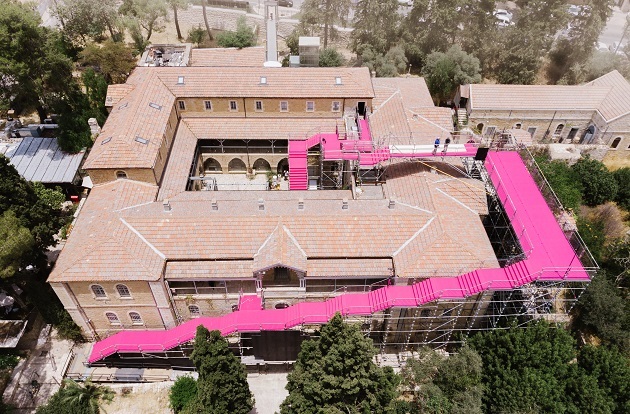
Apart from being a venue for the annual design week, the edifice of the house was itself transformed into an exhibit. A scaffold wrapped around the house by Tel Aviv-based HQ Architects allowed visitors to look down into it from a new third floor, at the same time creating a viewing platform from which to look out at the city. Carpeted in pink, its floors stood out against the sandy stone of the city below and played with the way the site was navigated, while negotiating strict conservation laws that restricted the structure from being significantly altered.
While dominated by the more showy, immersive exhibits, Jerusalem Design Week was not without subtler moments, particularly when it came to contemporary craft. In a delicate use of thread work, Yuri Himoro’s double layered textile depicting a green, graphic landscape allowed you to cut out sections to reveal elements of an alternative landscape underneath, such as a blue river. It felt inappropriate to tamper with the beautiful weave, but Himoro insisted that it was her intention for us to do this. The impressive quality of this craftsmanship, combined with its contemporary aesthetic, has allowed double-layered fabrics like these, with multiple narratives embedded physically into them, to be used to upholster actual furniture that you can snip away at.
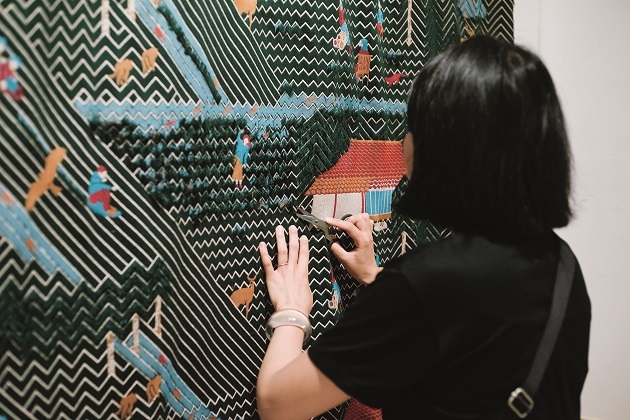 Satoyama by Yuri Himuro
Satoyama by Yuri Himuro
Although Jerusalem Design Week attempts to tie the city together – Israelis and Palestinians alike – it doesn’t really do justice to the deep rift that divides Israel like a river of blood. The theme for the event, ‘East’, appears to be more of a reflection on Israel’s geographical position in the so-called Middle East and what that actually means. Rather than talking about the conflict happening on the doorstep, curators Tal Erez and Anat Safran have chosen to focus on the wider fact that our world map is a political construct crafted to suit the interests of Western colonisers.
‘We tend to look at East from a cliché perspective, but the biggest discovery was there is no such thing as East because the world is round,’ says Erez. ‘What we call East is a construct, and what we throw at it socially, politically, geographically.’ Among the exhibits that delve into this subject were a set of passport photos and stamps reflecting the bureaucracy of citizenship, a painstakingly truthful three-channel film installation about what it means to be ‘Asian’ through American eyes, and a set of 3D-printed teapots by Unfold Design Studio inspired by historic teapots from different geographies. The issue of our place in the world map and the construction of national identities is a valid proposition in itself, although it is hard not to come away feeling that it obscures the elephant in the room.
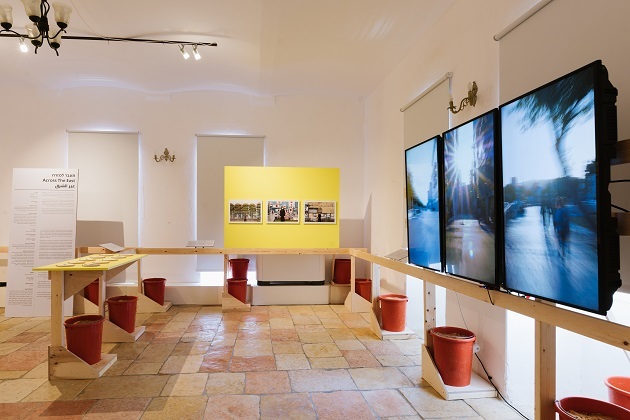 A view of the installation interior
A view of the installation interior
Beyond the walls of Hansen House, a more direct exploration of the Israel-Palestine conflict took place at the Museum of Islamic Art. A thoughtful installation conceptualised by Oded Ben Yehuda and designed with Ilai Ovadia saw walls plastered with sentences that express the turmoil and heart-wrenching pain that surrounds Israelis’ national identity.
Jerusalem Design Week may not be of the magnitude of the most established international design weeks but it outdoes many of them in the calibre of its work, making you want to linger rather than scramble to the next exhibit. While the contested city might not be most obvious centre for design, this annual gathering manages to combine the cultural awareness of an art biennale with the exuberance of a festival. Comparable to Milan’s Triennale or Istanbul Design Biennial, it teases out ideas while turning design into an alluring spectacle.
The full version of this article originally appeared in Icon 195, the September 2019 edition that also featured stories on waste and the circular economy, Frank Lloyd Wright’s Fallingwater and more
















